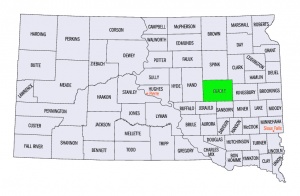Difference between revisions of "Beadle County (South Dakota, USA)"
| [unchecked revision] | [unchecked revision] |
GameoAdmin (talk | contribs) (CSV import - 20130816) |
GameoAdmin (talk | contribs) (CSV import - 20130820) |
||
| Line 1: | Line 1: | ||
| − | + | [[File:SD_Beadle.jpg|300px|thumb|right|''Beadle County, South Dakota. | |
U.S. Census TIGER/Line map | U.S. Census TIGER/Line map | ||
'']] In the 1950s Beadle County, [[South Dakota (USA)|South Dakota]], in the northeastern part of the state, had five organized Mennonite congregations, besides the [[Hutterian Brethren (Hutterische Brüder)|Hutterian Brethren]] and a mission station in Huron. Approximately 1,300 Mennonites, including about 200 Hutterites, lived in the county. The Mennonite settlement extended north into Spink County and northeast into Clark County. Besides the Hutterites, two other branches were represented in the settlement—the [[General Conference Mennonite Church (GCM)|General Conference]] and the [[Krimmer Mennonite Brethren|Krimmer Mennonite Brethren]], the latter being more numerous. The Krimmer Mennonite Brethren arrived in the county in 1902 and soon organized the Bethel congregation (KMB), which in 1950 was the largest Mennonite congregation in the area. | '']] In the 1950s Beadle County, [[South Dakota (USA)|South Dakota]], in the northeastern part of the state, had five organized Mennonite congregations, besides the [[Hutterian Brethren (Hutterische Brüder)|Hutterian Brethren]] and a mission station in Huron. Approximately 1,300 Mennonites, including about 200 Hutterites, lived in the county. The Mennonite settlement extended north into Spink County and northeast into Clark County. Besides the Hutterites, two other branches were represented in the settlement—the [[General Conference Mennonite Church (GCM)|General Conference]] and the [[Krimmer Mennonite Brethren|Krimmer Mennonite Brethren]], the latter being more numerous. The Krimmer Mennonite Brethren arrived in the county in 1902 and soon organized the Bethel congregation (KMB), which in 1950 was the largest Mennonite congregation in the area. | ||
| − | |||
| − | |||
{{GAMEO_footer|hp=Vol. 1, p. 254|date=1953|a1_last=Kleinsasser|a1_first=J. J|a2_last= |a2_first= }} | {{GAMEO_footer|hp=Vol. 1, p. 254|date=1953|a1_last=Kleinsasser|a1_first=J. J|a2_last= |a2_first= }} | ||
Revision as of 18:46, 20 August 2013
In the 1950s Beadle County, South Dakota, in the northeastern part of the state, had five organized Mennonite congregations, besides the Hutterian Brethren and a mission station in Huron. Approximately 1,300 Mennonites, including about 200 Hutterites, lived in the county. The Mennonite settlement extended north into Spink County and northeast into Clark County. Besides the Hutterites, two other branches were represented in the settlement—the General Conference and the Krimmer Mennonite Brethren, the latter being more numerous. The Krimmer Mennonite Brethren arrived in the county in 1902 and soon organized the Bethel congregation (KMB), which in 1950 was the largest Mennonite congregation in the area.
| Author(s) | J. J Kleinsasser |
|---|---|
| Date Published | 1953 |
Cite This Article
MLA style
Kleinsasser, J. J. "Beadle County (South Dakota, USA)." Global Anabaptist Mennonite Encyclopedia Online. 1953. Web. 18 Apr 2024. https://gameo.org/index.php?title=Beadle_County_(South_Dakota,_USA)&oldid=75261.
APA style
Kleinsasser, J. J. (1953). Beadle County (South Dakota, USA). Global Anabaptist Mennonite Encyclopedia Online. Retrieved 18 April 2024, from https://gameo.org/index.php?title=Beadle_County_(South_Dakota,_USA)&oldid=75261.
Adapted by permission of Herald Press, Harrisonburg, Virginia, from Mennonite Encyclopedia, Vol. 1, p. 254. All rights reserved.
©1996-2024 by the Global Anabaptist Mennonite Encyclopedia Online. All rights reserved.

